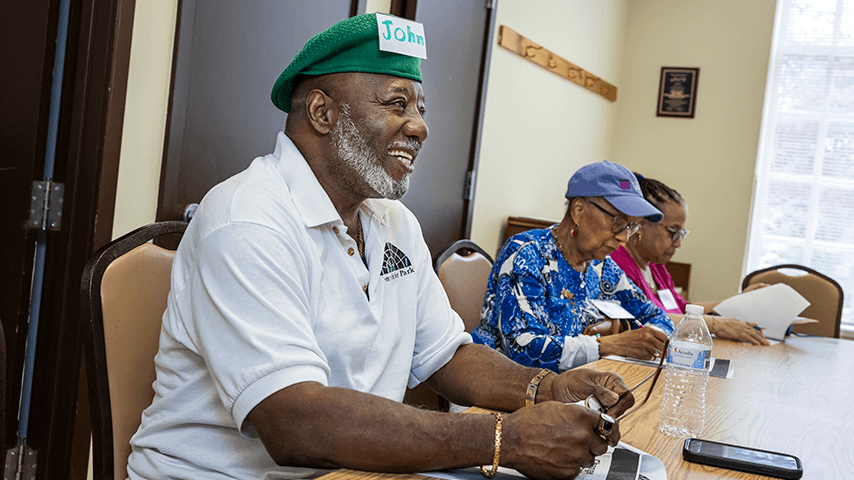Tips for Communicating Effectively with Workshop Participants
8 min read

We often find ourselves juggling multiple responsibilities as we plan, implement, and run evidence-based programs. One consistent responsibility is ensuring we effectively communicate with our participants, team, and partners. Focusing on respect, empathy, active listening, non-verbal communication, and practical engagement strategies can lead to success!
The importance of respect
How can we learn what someone else considers respectful? We ASK.
When working with older adults we may also show respect by:
- Asking the person how they want to be addressed—This should be done during outreach and recruitment as well as the start of a workshop or event. Find out if they prefer a more formal or informal approach. Do they like to be called by their first or last name? If your team uses notes or documentation, include their preferred name in your documentation so everyone is aware.
- Avoiding slang, medical terminology, or jargon—use clear simple language that is easy to understand.
- Learning about their expectations, experiences, and perspectives of the situation they’re in. Are they a proud person who never anticipated needing hands-on care? Are they still able to complete certain tasks, even if it takes longer to do so? Do they still see themselves as spry and active despite mobility limitations? These insights can help you tailor your communication to ensure you are communicating in a respectful way.
Remember: Respect is in the eye of the beholder.
What's empathy got to do with it?
The Cambridge Dictionary defines empathy as “the ability to share someone else’s feelings or experiences by imagining what it would be like to be in that person’s situations."1 It’s not necessary to have been in the person’s exact situation to express empathy. Instead, we imagine what the experience was like for that person. This skill helps us be non-judgmental and compassionate.2
Why non-verbal communication matters
Research shows that non-verbal communication has between 65-93% more impact than spoken words. When non-verbal and verbal communication disagree, we’re more likely to believe non-verbal communication.3 These five important aspects of non-verbal communication can be incorporated during your workshop and are keys to successful non-verbal communication. These strategies can apply to both you as a facilitator and the participants.
- Eye contact: Recognize the individual’s expectations and match those expectations. Some people may be comfortable with direct eye contact,4,5 whereas others may not. During your session make note of any reaction participants have to eye contact. Do they show signs of discomfort? If so, consider using minimal eye contact with that person. You may consider having a conversation after the session to learn more about what feels comfortable to them.
- Facial expressions: A picture is worth a thousand words; so are our facial expressions. There’s a balance between having a poker face and allowing your face to express emotions.
To find the right balance, consider what your eyes are saying?4,5 Is your forehead relaxed or are your eyebrows raised? Are you smirking or smiling? Did you roll your eyes at a comment someone made? During a workshop session, participants may share private, intimate information about themselves. It is critical that leaders and facilitators are cognizant of their facial expressions, particularly when participants are reporting on their health conditions, experiences, and goals.
During your session, be aware of what your facial expressions are saying. If your face says something you didn’t intend, it’s okay to acknowledge that to participants. You may also consider discussing the impact or reaction someone has to facial expressions to build respect and group cohesion. - Personal space: Everyone has their own “safety zone,” the area they are comfortable allowing others into. This “zone” can change depending on the person’s surroundings or mood. Be mindful not to get too close, which can feel intimidating or uncomfortable. If you’re too far away the person may assume you’re not interested or engaged in the conversation.4 Consider what room setup would be most comfortable for participants. If you are running a multi session program, your setup may change as participants become more comfortable with each other. You may start with a more classroom style set up and move to a circle as the group gets to know each other.
- Posture: Practice using Egan’s SOLER Model.6 This method creates an environment of safety and empathy when working with participants.
S—Sit Squarely—be on the same level as the person you’re talking to. If they’re sitting, you should sit, too. Position yourself so you are predominantly facing the other person showing you are open and attentive.
O—Open posture—keep arms and legs uncrossed to avoid looking defensive or uninterested.
L—Lean forward—Lean forward slightly to show interest in what the other person is saying.
E—Eye contact—use eye contact as appropriate for the individual.
R—Relaxed—keep your muscles and limbs relaxed showing you are present and not in a rush to leave.
- Hand position: Open palms help establish rapport and convey trustworthiness. When we hide our hands in pockets or behind us it communicates lack of engagement and being disconnected. If a person is becoming upset avoid big gestures with your hands, instead keep them low and in front of you. 4,5
Verbal communication strategies
Consider these verbal communication strategies and incorporate them as frequently as possible during your sessions:
- Be clear and concise. Use action words, visual aids, and concrete terms3,5 that refer to tangible objects that you can count, touch, or name.
- Be courteous and open-minded. During difficult conversations empathy can go a long way. Avoid arguing or using offensive words.7
- Pay attention to your tone. Your tone includes volume, projection, intonation, and word choice. When we focus on positive words, we create good will and trust. Unclear or negative words can lead to misunderstandings.3,5 For example, “You have to work hard to maintain your health” is an unclear statement. It does not explain what “working hard” means. Instead, you might say, “To maintain your health you need to exercise daily, eat a variety of nutritious foods like fruits, vegetables, grains, and protein, and get 6-8 hours of sleep."
Avoid using Elderspeak, the slow, simplified communication with a singsong cadence that sounds like you’re talking to a baby or toddler. Research shows that older adults living with dementia react negatively to this tone, disregarding instructions, yelling, or becoming agitated.8 Make sure your tone reflects who you are speaking to—another adult. - Use multiple modes of communication. Everyone communicates differently, and you may find it’s helpful to include visual or written communication to help support your discussion.5
- Practice active listening. We have two ears, and one mouth. When we’re actively listening, we minimize distractions and avoid interruptions, judgment, or counterarguments. Practice rephrasing or paraphrasing what the person said to ensure your own understanding. Ask open-ended questions to promote discussion and dialogue.3,7
- Build your emotional intelligence. Understand and manage your own emotions. Validate the other person’s feelings. Remember the person’s response isn’t necessarily directed at you but at the situation. Use empathy to show understanding.3
- Embrace feedback. Though it may be difficult to hear constructive feedback, embrace it! Allow yourself the opportunity to improve by inviting others to share their feedback about your communication style/strategies. This practice helps you build more productive communication strategies for the future.5,7
Practical engagement strategies
Talking about health conditions, managing symptoms, changing diets and lifestyles, or challenges with working with family, friends and medical providers can elicit many emotions. Participants may get upset and cry during difficult activities; or become agitated and raise their voice. They may try to control the conversation, refuse to participate, or distract fellow participants. Following these practical engagement strategies can help you support participants effectively throughout the program.
- Practice active listening. Use open-ended questions, reflect feelings, and paraphrase or restate what the person said to check understanding.9
- Focus on the feelings. When you address the person’s feelings you are validating their experience, which builds rapport and helps them feel understood.2
- Speak in a calm, neutral tone. Remaining calm helps create a stable and safe environment. Be mindful of your tone throughout the conversation.
- Empower with choice. You will get a more positive response when you offer choices. This promotes autonomy and demonstrates respect to participants.2
- Be open. Create a safe space for participants to share and express their feelings.9
- Consider what needs aren't being met. Think of Maslow's Hierarchy of Needs.10 Are any of the basic needs missing like food, water, shelter, clothing?10 If able, try to address these needs to ensure participants are ready and able to engage in the conversation.
When people feel like they are being heard and understood, tension can dissipate. By engaging in empathetic, active listening, we can de-escalate many challenging situations. Remember, people are often reacting to an underlying emotion that needs to be resolved.
When we can address that emotion, we can develop positive solutions.
Sources
1. Empathy Definition. Found on the internet at https://dictionary.cambridge.org/us/dictionary/english/empathy
2. CPI’s Top 10 De-escalation Tips. July 5, 2024. Found on the internet at https://www.crisisprevention.com/en-GB/blog/general/cpi-top-10-de-escalation-tips/
3. 8 Ways You Can Improve Your Communication Skills. August 30, 2021, updated Jan. 8, 2024. Found on the internet at https://professional.dce.harvard.edu/blog/8-ways-youcan-improve-your-communication-skills/
4. Nonverbal Communication Skills: 19 Theories & Findings. June 8, 2021. Found on the internet at https://positivepsychology.com/nonverbal-communication/
5. Strategies in Communication: Your Guide to Better Connections. October 28, 2024. Found on the internet at https://www.coursera.org/articles/strategies-in-communication
6. The SOLER Model Script. Found on the internet at https://www.stockton.ac.uk/media/3545/the-soler-model-script.pdf
7. 10 Tips for Effective Communication in the Workplace. June 17, 2024. Found on the internet at https://www.forbes.com/advisor/business/effective-communication-workplace/
8. Don’t Call Me ‘Sweetie’. April 11, 2017. Found on the Internet at https://www.aarp.org/caregiving/basics/info-2017/discouraging-elderspeak-fromcaregivers- fd.html
9. Crisis Intervention and De-Escalation Techniques Presentation. Found on the Internet at http://www.cit.memphis.edu/modules/De-Escalation/presentations/FL%20- %20De%20Escalation%20Techniques.pdf
10. Maslow’s Hierarchy of Needs. April 2, 2024. Found on the internet at https://www.verywellmind.com/what-is-maslows-hierarchy-of-needs-4136760
